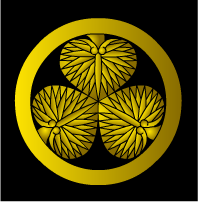Gosankyō
The Gosankyō ( Japanese 御 三 卿 ) were three branches of the Tokugawa family in the Japanese Edo period . All three houses go back to the sons or grandsons of the eighth Tokugawa Shogun Yoshimune (1684-1751), who founded these three houses as a supplement, or as a replacement, of the three traditional Tokugawa branch lines, the Gosanke . His second son, Munetake , founded the Tayasu lineage ( 田 安家 ), his fourth son, Munetada , founded the Hitotsubashi lineage ( 一 橋 家 ), and his grandson Shigeyoshi , second son of the ninth Shogun Ieshige , founded the Shimizu lineage ( 清水 家 ).
In contrast to the Gosanke, who as influential feudal lords ( daimyō ) controlled the important Han Owari , Kishū and Mito , the Gosankyō did not have their own Han, but resided in the area of Edo Castle and received an income from the lands in the vicinity of Edo administered directly by the shogunate. The Gosankyo had the right to bear the family name Tokugawa like the main line. The names of the individual lines are derived from the gates of the Edo Castle, near which the lines had their residence.
The Gosankyō fulfilled their intended task of providing adoptable sons to ensure the continuation of the Tokugawa dynasty on several occasions: The 11th Shogun Tokugawa Ienari and the 15th Shogun Tokugawa Yoshinobu came from the House of Hitotsubashi, with Yoshinobu himself from the House of Mito- Tokugawa was adopted because the Hitotsubashi had no heir themselves. The Tayasu did not provide an heir to the Tokugawa main line until after the Meiji Restoration, namely Tokugawa Iesato , who rose to become the head of the family of the Tokugawa after the resignation of Yoshinobu as a shogun and became an influential politician of the Meiji period .
When the shogunate was dissolved in the Meiji Restoration in 1868, the Tayasu and Hitotsubashi were able to secure their own land from the land of the shogunate and found the Tayasu-han ( 田安藩 ) and the Hitotsubashi-han ( 一 橋 藩 ). However, the time of the houses as feudal lords was short-lived. After a peasant revolt, the land of the Tayasu passed into the hands of the government a year later, that of the Hitotsubashi with the dissolution of the Han in 1871. With the introduction of the new nobility ranks ( Kazoku ) in 1884, the heads of the families were given the rank of Hakushaku ( Graf) raised.
Genealogy of the Gosankyō
Tayasu House
- Munetake (1716–1771, r. 1731–1771)
- Haruaki (1753–1774, r. 1771–1774)
- Narimasa (1779-1846, r. 1787-1836)
- Naritaka (1810-1845, r. 1836-1839)
- Yoshiyori (1828–1876, r. 1839–1863)
- Takachiyo (1860-1865, r. 1863-1865)
- Kamenosuke (1863–1940, r. 1865–1868)
- Yoshiyori (second time) (1828–1876, r. 1868–1876)
Shimizu House
- Shigeyoshi (1745–1795, r. 1758–1795)
- Atsunosuke (1796–1799, r. 1798–1799)
- Nariyuki (1801-1846, r. 1805-1816)
- Narinori (1810-1827, r. 1816-1827)
- Narikatsu (1820–1849, r. 1827–1846)
- Akitake (1853–1910, r. 1866–1868)
- Atsumori (1856–1924, r. 1870–1924)
Hitotsubashi house
- Munetada (1721–1765, r. 1735–1764)
- Harusada (1751-1827, r. 1764-1799)
- Nariatsu (1780-1816, r. 1799-1816)
- Narinori (1803-1830, r. 1816-1830)
- Narikura (1818–1837, r. 1830–1837)
- Yoshimasa (1825-1838, r. 1837-1838)
- Yoshinaga (1823–1847, r. 1838–1847)
- Shōmaru (1846–1847, r. 1847)
- Yoshinobu (1837–1913, r. 1847–1866)
- Mochiharu (1831-1884, r. 1866-1884)


